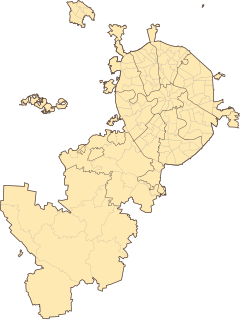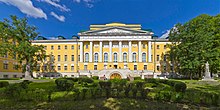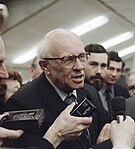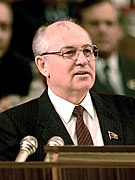Moscow State University
Московский государственный университет имени М. В. Ломоносова | |
 Coat of arms of the Lomonosov State University of Moscow | |
| Motto | Наука есть ясное познание истины, просвещение разума... |
|---|---|
Motto in English | Learning is the clear attainment of truth, the enlightening of reason... |
| Type | Public |
| Established | 23 January 1755 (1755-01-23) |
| Rector | Viktor Sadovnichiy |
Academic staff | 5,000 |
| Students | 47,000 |
| Undergraduates | 40,000 |
| Postgraduates | 7,000 (estimate) |
| Location | Moscow , Russia |
| Campus |
|
| Language | Russian |
| Colours | Blue |
| Affiliations | Association of Professional Schools of International Affairs Institutional Network of the Universities from the Capitals of Europe International Forum of Public Universities |
| Website | www.msu.ru |
| Building details | |
Главное здание МГУ (ГЗ МГУ) | |
 | |
 Location within Moscow | |
| General information | |
| Location | Moscow, Russia |
| Coordinates | 55°42′14″N 37°31′43″E / 55.7039°N 37.5286°E / 55.7039; 37.5286Coordinates: 55°42′14″N 37°31′43″E / 55.7039°N 37.5286°E / 55.7039; 37.5286 |
| Completed | 1953 |
| Height | |
| Architectural | 240 m (787 ft) |
| Top floor | 214 m (702 ft)[1] |
| Technical details | |
| Floor count | 42 |
| Floor area | 1,000,000 m2 (10,763,910.417 sq ft) |
Moscow State University (MSU; Russian: Московский государственный университет имени М. В. Ломоносова, often abbreviated МГУ) is a coeducational and public research university located in Moscow, Russia. It was founded on 23 January [O.S. 12 January] 1755 by Mikhail Lomonosov. MSU was renamed after Lomonosov in 1940 and was then known as Lomonosov University. It also houses the tallest educational building in the world.[2] Its current rector is Viktor Sadovnichiy. According to the 2018 QS World University Rankings, it is the highest-ranking Russian educational institution and is widely considered the most prestigious university in the former Soviet Union.
Contents
1 History
1.1 Imperial Moscow University
1.2 Moscow State University
2 Campus
3 Faculties
4 Transport connections
5 Institutions and research centers
6 Staff and students
7 Academic reputation
8 Famous alumni and faculty
9 See also
10 Notes and references
11 External links
History
Imperial Moscow University

The Principal Medicine Store building on Red Square that housed Moscow University from 1755 to 1787

Main buildings of the university in Mokhovaya Street, 1798
Ivan Shuvalov and Mikhail Lomonosov promoted the idea of a university in Moscow, and Russian Empress Elizabeth decreed its establishment on 23 January [O.S. 12 January] 1755.
The first lectures were given on 7 May [O.S. 26 April]. Russians still celebrate 25 January as Students' Day. (Foundation of the University is traditionally associated with the feast of Saint Tatiana, celebrated by the Russian Orthodox Church on 12 January Julian, which corresponds to 25 January Gregorian in the 20th–21st centuries.)
Saint Petersburg State University and Moscow State University engage in friendly rivalry over the title of Russia's oldest university. Though Moscow State University was founded in 1755, its competitor in St. Petersburg has had a continuous existence as a "university" since 1819 and sees itself as the successor of an academy established on 24 January 1724, by a decree of Peter the Great.
The present Moscow State University originally occupied the Principal Medicine Store on Red Square from 1755 to 1787. Catherine the Great transferred the University to a Neoclassical building on the other side of Mokhovaya Street; that main building was constructed between 1782 and 1793 in the Neo-Palladian style, to a design by Matvei Kazakov, and rebuilt by Domenico Giliardi after the fire consumed much of Moscow in 1812.
In the 18th century, the University had three departments: philosophy, medicine, and law. A preparatory college was affiliated with the University until its abolition in 1812. In 1779, Mikhail Kheraskov founded a boarding school for noblemen (Благородный пансион) which in 1830 became a gymnasium for the Russian nobility. The university press, run by Nikolay Novikov in the 1780s, published the most popular newspaper in Imperial Russia: Moskovskie Vedomosti.

As of 2015[update], the Old Building housed the Department of Oriental studies
In 1804, medical education split into clinical (therapy), surgical, and obstetrics faculties. During 1884–1897, the Department of Medicine—supported by private donations, and the municipal and imperial governments—built an extensive, 1.6-kilometer-long, state-of-the-art medical campus in Devichye Pole, between the Garden Ring and Novodevichy Convent; this had been designed by Konstantin Bykovsky, with university doctors like Nikolay Sklifosovskiy and Fyodor Erismann acting as consultants. The campus, and medical education in general, were separated from the Moscow University in 1930. Devichye Pole was operated by the independent I.M. Sechenov First Moscow State Medical University and by various other state and private institutions.
The roots of student unrest in the University reach deep into the nineteenth century. In 1905, a social-democratic organization emerged at the University and called for the overthrow of the Czarist government and the establishment of a republic in Russia. The imperial government repeatedly threatened to close the University. In 1911, in a protest over the introduction of troops onto the campus and mistreatment of certain professors, 130 scientists and professors resigned en masse, including such prominent men as Nikolay Dimitrievich Zelinskiy, Pyotr Nikolaevich Lebedev, and Sergei Alekseevich Chaplygin; thousands of students were expelled.
Moscow State University
After the October Revolution of 1917, the institution began to admit the children of the proletariat and peasantry. In 1919, the University abolished fees for tuition and established a preparatory facility to help working-class children prepare for entrance examinations. During the implementation of Joseph Stalin's first five-year plan (1928–1932), prisoners from the Gulag were forced to construct parts of the newly expanded University.

The first Humanities Building
After 1991, nine new faculties were established. The following year, the University gained a unique status: it is funded directly from the state budget (bypassing the Ministry of Education), thus providing the University a significant level of independence.
On 6 September 1997, the French electronic musician Jean Michel Jarre, whom the mayor of Moscow had specially invited to perform, used the entire front facade of the University as the backdrop for a concert: the frontage served as a giant projection screen, with fireworks, lasers, and searchlights all launched from various points around the building. The stage stood directly in front of the building, and the concert, entitled "The Road To The 21st Century" in Russia but renamed "Oxygen In Moscow" for worldwide release in video/DVD, attracted a world-record crowd of 3.5 million people.

Students celebrating the 250th anniversary of the university in 2005
On 19 March 2008, Russia's most powerful supercomputer to date, the SKIF MSU (Russian: СКИФ МГУ; skif means "Scythian" in Russian) was launched at the University. Its peak performance of 60 TFLOPS (LINPACK - 47.170 TFLOPS) makes it the fastest supercomputer in the Commonwealth of Independent States.[3][4][5]
Campus

Building of the Faculties of Biology and of Soil Science
Since 1953, most of the faculties have been situated on Sparrow Hills, in the southwest of Moscow, 5 km from the city centre. The main building was designed by architect Lev Vladimirovich Rudnev. In the post-war era, Joseph Stalin ordered seven huge tiered neoclassic towers to be built around the city. It was built using Gulag labour, as were many of Stalin's Great Construction Projects in Russia.[6] Located on Moscow's outskirts at the time of its construction, the location of the main building is now about half-way between the center of Moscow at the Kremlin and the city's current limits. The Journalism Department now occupies the university's original location in downtown Moscow across from the Manezh, steps from the Kremlin and other government buildings. Indeed, frequent student unrest, including street protests, well pre-dating 1917 may be one reason why Stalin's planners sited the university across the Moscow River, so far away.[citation needed]
The MSU main building was the tallest building in the world outside of New York City at the time of its construction, and remained the tallest building in Europe until 1990. The central tower is 240 m tall, 36 stories high, and flanked by four huge wings of student and faculty accommodations. It is said to contain a total of 33 kilometres of corridors and 5,000 rooms.

The university library
Facilities available inside the building include a concert hall, a theater, a museum, administrative services, a library, a swimming pool, a police station, a post office, a laundry, a hairdresser's salon, several canteens, bank offices and ATMs, shops, cafeterias, a bomb shelter, etc. Along with the university administration, the Museum of Earth Sciences and four of the main faculties – Faculty of Mechanics and Mathematics, the Faculty of Geology, the Faculty of Geography, and the Faculty of Fine and Performing Arts – now reside in the Main building. The star on the top of the tower is large enough to include a small room and a viewing platform; it weighs 12 tons. The building's facades are ornamented with giant clocks, barometers, thermometers, statues, carved wheat sheaves, and Soviet crests. It stands before a terrace featuring statues of male and female students gazing optimistically and confidently into the future.
While the Sparrow Hills were on the outskirts of the city at the time of the construction of the main building, they are now about halfway from the Kremlin to the city limits. Several other buildings and sports facilities were later added to the campus, including the only baseball stadium in Russia. Currently, a new building is under construction for the social sciences faculties, and another new one of vast size has just been built for the library, which is the second-largest in Russia by volume (number of books). The university also has several dormitory buildings in the Southwest of Moscow, outside the campus.
The historical building on Mokhovaya Street now mainly houses the Faculty of Journalism, the Faculty of Psychology, and The Institute of Asian and African Studies. The university includes a number of faculty buildings located near Manege Square in the centre of Moscow and a number of campuses abroad in Ukraine, Kazakhstan, Tajikistan and Uzbekistan.
The university's main library is one of the largest in Russia. Current estimates suggest that it contains approximately 9,000,000 volumes. The library serves in the area of 55,000 readers per year, using approximately 5,500,000 books.
The university offers classes on its main campus not only in Moscow, but also on campuses in Armenia, Ukraine, Kazakhstan, Azerbaijan and Uzbekistan. These include the Puschino MSU campus, Podmoskovny MSU campus, Chernomorsky MSU campus and Kazakhstan MSU campus. The Ulyanovsk branch of MSU was reorganized into Ulyanovsk State University in 1996.
Faculties
As of September 2009, the university has 39 faculties and 15 research centres. A number of small faculties have been opened recently, such as Faculty of Physics and Chemistry and Higher School of Television. Evening classes are conducted by the Faculties of Economics, History, Journalism, Philology, Psychology and Sociology while the Faculty of Journalism offers a correspondence degree program. Here is the full list of faculties, according to the official website:[7]
- Faculty of Mechanics and Mathematics
- Faculty of Computational Mathematics and Cybernetics
- Faculty of Physics
- Faculty of Chemistry
- Faculty of Materials Science
- Faculty of Biology
- Faculty of Bioengineering and Bioinformatics
- Faculty of Soil Science
- Faculty of Geology
- Faculty of Geography
- Faculty of Fundamental Medicine
- Faculty of History
- Faculty of Philology
- Faculty of Philosophy
- Faculty of Economics
- Faculty of Law
- Faculty of Journalism
- Faculty of Psychology
- The Institute of Asian and African Studies
Faculty of Sociology [ru]
- Faculty of Foreign Languages and Area Studies
- Faculty of Public Administration
- Faculty of World Politics
- Faculty of Political Science
- Faculty of Fine and Performing Arts
- Faculty of Global Studies
- Faculty of Education
- Graduate School of Business Administration
- Faculty of Physics and Chemistry
- Moscow School of Economics
- Higher School of Translation and Interpretation
- Higher School of Public Administration
- Higher School of Public Audit
- Higher School of Administration and Innovations
- Higher School of Innovative Business Administration
- Higher School of Contemporary Social Sciences
- Higher School of Television
- Faculty of Further Education
- Faculty of Military Training
Transport connections
Metro: Universitet station
Universitet station
Bus: 1, 47, 57, 58, 67, 67к, 103, 111, 113, 119, 130, 187, 260, 661, 715, 902
Trolleybus: 4, 7, 28, 34, 34к, 49
Tram: 14, 26, 39
Institutions and research centers
Skobeltsyn Institute of Nuclear Physics
- Institute of Mechanics
- Sternberg Astronomical Institute
A.N. Belozersky Institute of Physico-Chemical Biology
- Research Computing Center
N.N. Bogolyubov Institute for Theoretical Problems of Microphysics- White Sea Biological Station
- Moscow University Herbarium
- and several others
Staff and students
Currently the university employs more than 4,000 academics and 15,000 support staff. Approximately 5,000 scholars work at the university's research institutes and related facilities. More than 40,000 undergraduates and 7,000 advanced degree candidates are enrolled. More than 5,000 specialists participate in refresher courses for career enhancement. Annually, the university hosts approximately 2,000 students, graduate students, and researchers from around the world.
Academic reputation
University rankings | |
|---|---|
| Global | |
ARWU World[8] | 93 |
| National | |
Interfax Russia[9] | 1 |

The main Building in winter
The university has well-established contacts with the most distinguished universities in the world, exchanging students and lecturers with the leading international institutions of higher education. It houses the UNESCO International Demography Courses, the UNESCO Hydrology Courses, the International Biotechnology Center, the International LASER Center, courses or seminars on Russian as a foreign language. In 1991 the French University College, the Russian-American University and the Institute of German Science and Culture were opened. The university has awarded honorary degrees to more than 60 scientists, statesmen and politicians from abroad. Many prominent university scholars and scientists in return hold honorary degrees from foreign academies and universities.
Moscow State University is one of Russia's most prestigious institutions of higher learning, and has demanding entry requirements for prospective students. Nonetheless, it performs inconsistently in international rankings. While it was placed 77th overall[10] by the Academic Ranking of World Universities and 112th[11] by QS World University Rankings, it was not included among the top 200 universities[12] by recent Times Higher World University Rankings and came in at 296th (based on the full THE World University Rankings in their iPhone application). On a highly cited and consistent ranking, Moscow State University ranked 43rd in 2008, 44th in 2009–2011, and 45th among 300 Best World Universities in 2012 compiled by Human Resources & Labor Review (HRLR) on Measurements of World's Top 300 Universities Graduates' Performance.[13] Despite its large number of faculties, Moscow State University seems to be strong mostly in natural sciences and mathematics (currently placed between 38th[11] and 75th[14] in the world) but considerably weaker in other disciplines. Despite the fact that it is still the highest ranked Russian university according to the three international rankings mentioned above (with the nearest Russian competitor being Saint Petersburg State University that scored 300–400th), the university was consistently placed outside top 5 nationally in 2010–2011 by Forbes[15] and Ria Novosti / HSE,[16] with both ratings based on data set collected by HSE from Russian Unified State Exam scores averaged per all students and faculties of university.
A few more narrowly specialized Moscow colleges, including the Moscow Institute of Physics and Technology and the Moscow State Institute of International Relations were split off from MSU at one time or another and have since established strong reputations of their own.
| 2014 | 2013 | 2012 | 2011 | 2010 | 2009 | |
|---|---|---|---|---|---|---|
Ria Novosti / HSE | 6th[17] | 7th[16] | 1st[18] | |||
Forbes | – | 6th[15] | – | |||
Ria Novosti / HSE (Multi-Faculty Universities) | 1st[19] | 1st[16] | 1st[18] | |||
Interfax / Echo Moskvy (Multi-Faculty Universities) | 1st [20] | 1st [21] | 1st [22] | 1st [23] | 1st [24] | 1st [25] |
| 2016 | 2015 | 2014 | 2013 | 2012 | 2011 | 2010 | 2009 | 2008 | 2007 | 2006 | 2005 | |
|---|---|---|---|---|---|---|---|---|---|---|---|---|
Academic Ranking of World Universities[26] | 87th | 86th | 84th | 79th | 80th | 77th | 74th | 78th | 70th | 77th | 70th | 68th |
QS World University Rankings[27] | 108th | 114th | 120th | 116th | 112th | 93rd | 101st | 183rd | 231st | 93rd | 93rd | |
Times Higher Education World University Rankings[12] | 161st | 196th | 226-250th | 201-225th | 214th | 296th | 237th | – | – | – | – | – |
Times Higher Education World Reputation Rankings [28] | 30th | 25th | 51-60th | 50th | – | 33rd | – | – | – | – | – | – |
Human Resources & Labor Review (Graduates performance)[26] | – | 44th | 44th | 44th | 43rd[clarification needed] | – | – | – | ||||
Academic Ranking of World Universities (Natural Sciences)[26] | 51–75th | 51–75th | 51–75th | 51–75th | 51–75th | 51–75th | 53–76th | 41st | – | – | – | |
QS World University Rankings (Natural Sciences)[28] | 60th | 34th | 84th | 44th | 38th | 29th | 30th | 29th | 27th | 44th | – |
Famous alumni and faculty
Famous alumni of the Moscow State University |
|---|
.mw-parser-output .mod-gallery{display:table}.mw-parser-output .mod-gallery-default{background:transparent;margin-top:0.5em}.mw-parser-output .mod-gallery-center{margin-left:auto;margin-right:auto}.mw-parser-output .mod-gallery-left{float:left}.mw-parser-output .mod-gallery-right{float:right}.mw-parser-output .mod-gallery-none{float:none}.mw-parser-output .mod-gallery-collapsible{width:100%}.mw-parser-output .mod-gallery .title{display:table-row}.mw-parser-output .mod-gallery .title>div{display:table-cell;text-align:center;font-weight:bold}.mw-parser-output .mod-gallery .main{display:table-row}.mw-parser-output .mod-gallery .main>div{display:table-cell}.mw-parser-output .mod-gallery .caption{display:table-row;vertical-align:top}.mw-parser-output .mod-gallery .caption>div{display:table-cell;display:block;font-size:94%;padding:0}.mw-parser-output .mod-gallery .footer{display:table-row}.mw-parser-output .mod-gallery .footer>div{display:table-cell;text-align:right;font-size:80%;line-height:1em}.mw-parser-output .mod-gallery .gallerybox .thumb img{background:none}.mw-parser-output .mod-gallery .bordered-images img{border:solid #eee 1px}.mw-parser-output .mod-gallery .whitebg img{background:#fff!important}.mw-parser-output .mod-gallery .gallerybox div{background:#fff!important}
|
As of 2017, 13 Nobel laureates, 6 Fields Medal winners and 1 Turing Award winner have been affiliated with the university. It is the alma mater of many famous writers such as Anton Chekhov and Ivan Turgenev, politicians such as Mikhail Gorbachev and Mikhail Suslov, as well as renowned mathematicians and physicists such as Boris Demidovich, Vladimir Arnold, and Andrey Kolmogorov.
See also
- Main building of Moscow State University
- Seven Sisters (Moscow)
- Education in Russia
- List of early modern universities in Europe
- List of universities in Russia
- List of rectors of Moscow State University
- List of honorary professors of the Moscow State University
Notes and references
^ "MSU Height"..mw-parser-output cite.citation{font-style:inherit}.mw-parser-output q{quotes:"""""""'""'"}.mw-parser-output code.cs1-code{color:inherit;background:inherit;border:inherit;padding:inherit}.mw-parser-output .cs1-lock-free a{background:url("//upload.wikimedia.org/wikipedia/commons/thumb/6/65/Lock-green.svg/9px-Lock-green.svg.png")no-repeat;background-position:right .1em center}.mw-parser-output .cs1-lock-limited a,.mw-parser-output .cs1-lock-registration a{background:url("//upload.wikimedia.org/wikipedia/commons/thumb/d/d6/Lock-gray-alt-2.svg/9px-Lock-gray-alt-2.svg.png")no-repeat;background-position:right .1em center}.mw-parser-output .cs1-lock-subscription a{background:url("//upload.wikimedia.org/wikipedia/commons/thumb/a/aa/Lock-red-alt-2.svg/9px-Lock-red-alt-2.svg.png")no-repeat;background-position:right .1em center}.mw-parser-output .cs1-subscription,.mw-parser-output .cs1-registration{color:#555}.mw-parser-output .cs1-subscription span,.mw-parser-output .cs1-registration span{border-bottom:1px dotted;cursor:help}.mw-parser-output .cs1-hidden-error{display:none;font-size:100%}.mw-parser-output .cs1-visible-error{font-size:100%}.mw-parser-output .cs1-subscription,.mw-parser-output .cs1-registration,.mw-parser-output .cs1-format{font-size:95%}.mw-parser-output .cs1-kern-left,.mw-parser-output .cs1-kern-wl-left{padding-left:0.2em}.mw-parser-output .cs1-kern-right,.mw-parser-output .cs1-kern-wl-right{padding-right:0.2em}
^ Blinnikov, Mikhail S. (13 June 2011). Geography of Russia and Its Neighbors. Guilford Press. p. 223. ISBN 9781606239216. Retrieved 2015-02-15.
^ "8th edition of the Top 50 list of the most powerful computers in Russia released". Top500.org. TOP500 Supercomputing Sites. 2008-04-16. Archived from the original on 2011-09-27. Retrieved 2011-10-29.
^
News[dead link]
^ "ru:В МГУ запустили мощнейший в СНГ компьютер". Km.ru. 2008-03-20. Retrieved 2016-07-14.
^ Figes, O. (2013) 'Just Send Me Word – A True Story of Love and Survival in the Gulag' pg. 192, Penguin Books: London.
^ MSU official site: University Structure (in Russian)
^ Academic Ranking of World Universities 2017
^ Сводный рейтинг выборки университетов России
^ Academic Ranking of World Universities – 2011| Top 500 universities | Shanghai Ranking – 2011 | World University Ranking – 2011. Shanghai Ranking. Retrieved on 2011-10-29.
^ ab "QS World University Rankings 2011 Results". Archived from the original on 2011-10-02.
^ ab Top 200 – The Times Higher Education World University Rankings 2010–2011. Timeshighereducation.co.uk. Retrieved on 2011-10-29.
^ "World Top 300 Universities Alumni Ranking". Chasecareer.net. Archived from the original on 2011-05-11. Retrieved 2012-06-06.
^ "Moscow State University". Archived from the original on 2011-11-18. Retrieved 2011-09-16.
^ ab Самые сильные университеты России. Таблица. Forbes.ru.(2010) Retrieved on 2011-10-29.
^ abc Рейтинг качества приема в российские государственные вузы–2010 | Все рейтинги | Лента новостей "РИА Новости". RIA Novosti (2011-02-28). Retrieved on 2011-10-29.
^ Качество приема в ВУЗы 2011: средние и минимальные баллы ЕГЭ. (в расчете на 1 предмет) по вузам, сгруппированным по профилям
^ ab М. С. Добрякова, ed. (2009). ЕГЭ и приём в вузы. Средний балл абитуриентов, поступивших в московские вузы по результатам ЕГЭ: август 2009 г.: доклад Государственног университета – Высшей школы экономики. Moscow: Гос. ун-т — Высшая школа экономики. ISBN 978-5-7598-0706-3.
PDF version
^ Качество приема в Вузы 2011: Результаты исследования | Лента новостей "РИА Новости. Ria.ru. Retrieved on 2011-10-29. Archived September 23, 2011, at the Wayback Machine.
^ Сводный рейтинг выборки университетов России. Retrieved on 2012-04-02.
^ Сводный рейтинг выборки университетов России. Retrieved on 2012-04-02.
^ Сводный рейтинг выборки университетов России. Retrieved on 2012-04-02.
^ Сводный рейтинг выборки университетов России. Retrieved on 2012-04-02.
^ Сводный рейтинг выборки университетов России. Retrieved on 2012-04-02.
^ Сводный рейтинг выборки университетов России. Retrieved on 2012-04-02.
^ abc Moscow State University. Shanghairanking.com.
^ Lomonosov Moscow State University Archived October 2, 2011, at the Wayback Machine.,Lomonosov Moscow State University. Topuniversities. Retrieved on 2011-10-29.
^ ab World Reputation Rankings 2014 | Times Higher Education (THE)
External links
| Wikimedia Commons has media related to Moscow State University. |
Moscow State University (in English)




